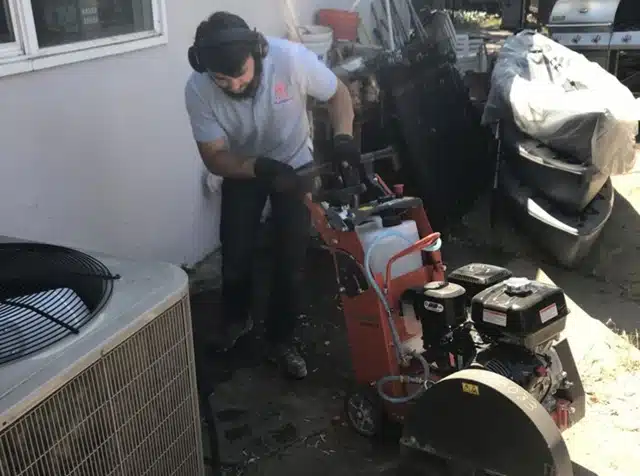Drain cleaning has evolved significantly over the years, and one of the most effective methods employed today is hydro jetting. This advanced technique uses high-pressure water streams to clear away the stubbornest clogs and buildup in plumbing systems.
Hydro jetting stands out as a premier solution for cleaning and maintaining drain and sewer lines. This method utilizes a specialized machine that generates a high-pressure water spray, capable of clearing pipes of scale, grease, and other debris that traditional methods can’t remove. The process starts by inserting a hose equipped with a multi-directional nozzle into the drain. This nozzle is designed to distribute powerful water jets that scour the interior surfaces of the pipes, effectively breaking down and washing away obstructions.
The technology behind this process allows it to not only unclog lines but also thoroughly cleanse them, restoring pipe diameter and flow capacity. This level of cleaning is particularly beneficial for commercial properties and residences that experience frequent or severe blockages. Hydro jetting is also environmentally safe because it uses only water to clean the pipes, avoiding the need for harmful chemicals that can leach into the environment.
The effectiveness of this process also extends to its ability to reach blockages that are typically out of reach for mechanical snakes or chemical cleaners. It can navigate bends and travel further down the plumbing line, ensuring a comprehensive clean. This makes it an ideal solution for complex plumbing systems or for maintaining pipes that serve critical operations in industries or larger buildings.
This type of work offers several notable benefits that make it a preferred choice for managing plumbing maintenance and emergencies. One of the primary advantages is its precision and versatility. The method is highly effective for a variety of plumbing issues, from removing minor clogs to addressing major blockages caused by roots and hardened deposits. Because the process cleans the entire diameter of the pipe, it prevents the quick recurrence of clogs, offering a longer-term solution compared to other methods.
Another key benefit — environmental safety. The process uses only water to clear lines, making it a more sustainable option than methods that involve chemical cleaners. This aspect is especially important in areas where environmental conservation is a priority, or where regulations restrict chemical use.
This process also contributes to the overall health of your plumbing system. Regular maintenance using this method can help detect potential problems early, such as minor leaks or weaknesses in the pipe structure. By addressing these issues early, homeowners and property managers can avoid costly repairs and extensive damage in the future. This is particularly beneficial in older systems where buildup and residue can cause frequent issues.

When considering hydro jetting for your plumbing needs, it’s important to evaluate several crucial factors to ensure that this powerful cleaning method is both effective and appropriate for your situation.
One of the first considerations should be the condition and material of your plumbing. Jetting involves the use of high-water pressure, which can range from 7,000 to 60,000 PSI. While this is highly effective at clearing out clogs and debris, it can potentially damage pipes that are old, weakened, or corroded. It is advisable to have a professional plumber perform a thorough inspection of your pipes with a camera before proceeding with this type of work. This inspection can identify any vulnerable areas or damage that might be exacerbated by high-pressure water.
The nature of the blockage is another critical factor. This process is incredibly effective against blockages caused by grease buildup, sludge, and other soft blockages because the high-pressure water can easily break these materials apart and wash them away. However, it is less effective against solid obstructions such as large tree roots or hard mineral deposits.
In these cases, mechanical methods like snaking or root cutting might be necessary either as a preliminary step before hydro jet or as an alternative solution.
The environmental impact of this type of work is generally low since it uses only water to clean the pipes without the need for harsh chemical agents. However, the proximity to natural water bodies and local environmental regulations may affect the suitability of jetting.
For instance, in areas close to lakes, rivers, or other sensitive ecosystems, the runoff could be subject to stringent regulations to prevent any potential contamination.
The cost of process jetting can vary depending on several factors, including the severity of the blockage, the length of the pipes, and the location. Generally, prices can range from moderate to high, but considering the effectiveness and the potential to prevent future problems, it often proves to be a worthwhile investment. Some regions, such as those in California or near big cities, might also see varied pricing based on local market conditions.
In summary, this type of work is a powerful, efficient, and environmentally friendly method for cleaning drains and pipes. It offers substantial benefits over traditional cleaning methods, particularly in terms of its ability to remove stubborn clogs and maintain the integrity of plumbing systems. When considering a hydro jet, it’s essential to consult with professional services to ensure it is suitable for your plumbing situation.
For those looking for jetting services, it’s advisable to choose a reputable provider who understands the local regulations and plumbing challenges. Companies like 5-Star Plumbing offer expert services tailored to your plumbing needs. Whether you’re dealing with a minor issue or require comprehensive cleaning, they can provide the necessary equipment and expertise.
You can contact this company right now to ask any questions you may have.
I bring over 9 years of dedicated plumbing experience to the table. As a seasoned professional in the plumbing industry, I've tackled a wide range of projects, from residential repairs to large-scale commercial installations.

